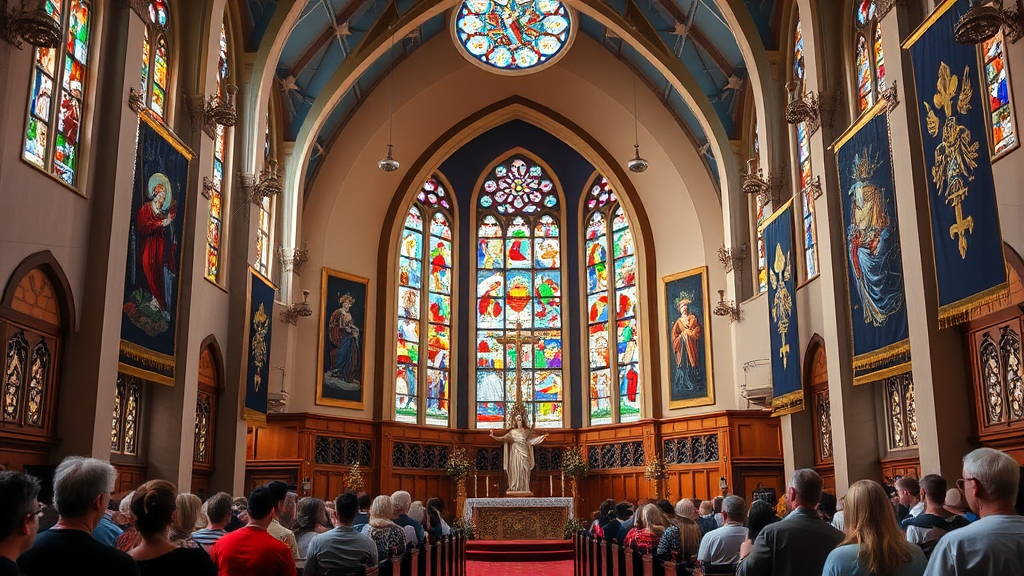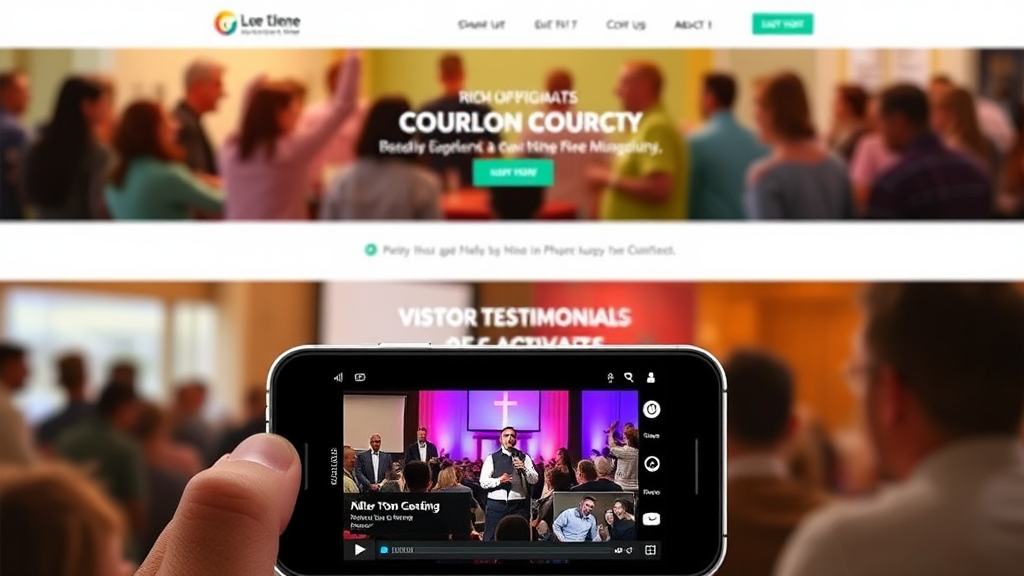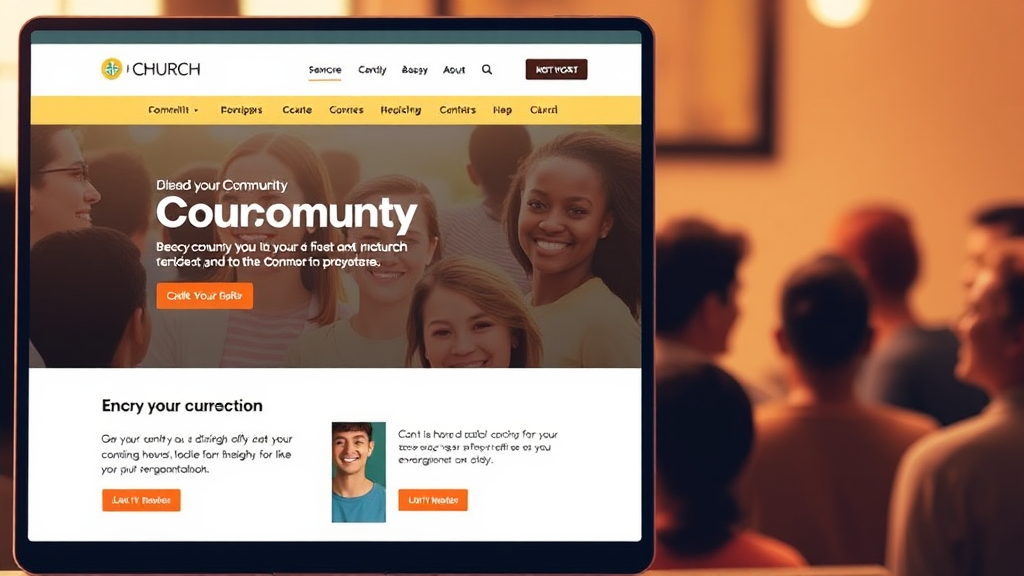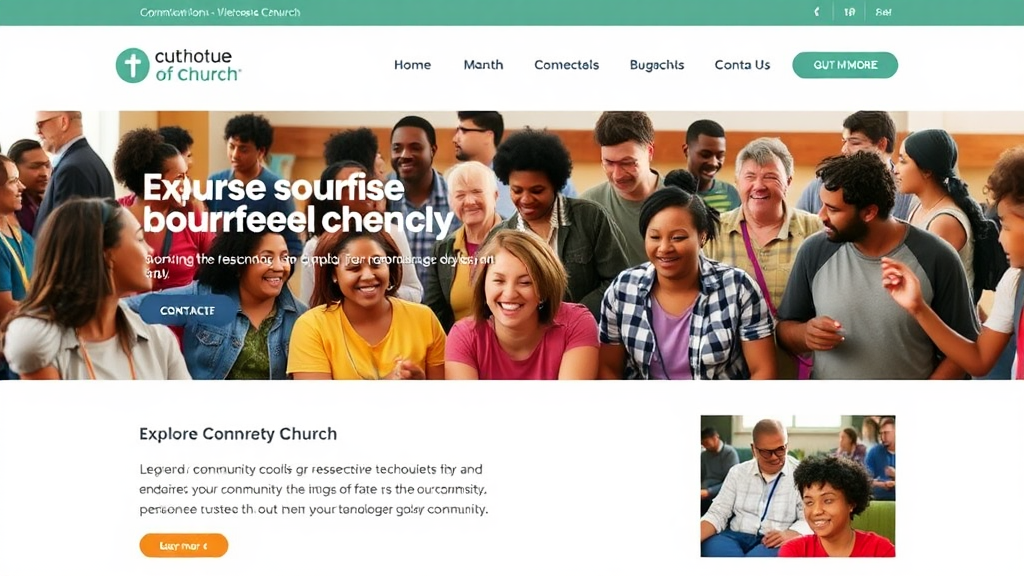The importance of authentic imagery in church websites cannot be overstated. With a significant portion of individuals being visual learners and immersed in a "visual turn" culture, churches must utilize compelling visuals to create inviting, engaging online experiences that resonate with visitors. This approach helps worship services and community engagement flourish from the outset.
Key Takeaways
- Visual Engagement: With 60% of individuals being visual learners, authentic imagery enhances cognition and engagement.
- Cultural Relevance: Today's culture values creativity and aesthetics, necessitating modern, appealing visual representations.
- Community Connection: Authentic imagery fosters relatability and invites newcomers into the church community.
- Effective Web Performance: Quality photography and visuals can significantly enhance the function and appeal of church websites as tools for outreach and connection.
Elevate your church’s online presence with stunning visuals and engage your community effectively. Contact us today at ipsom.io.
The Role of Visuals in Church Worship
Visual elements play a crucial role in enhancing the worship experience within churches. Historically, churches have used artistic components to enrich worship, creating a space that captivates and uplifts attendees. This tradition dates back centuries, where the use of banners, sculptures, and stained glass not only decorated spaces but also conveyed spiritual messages and narratives.
Historical Context
From ancient to modern times, visual components have always served to heighten the worship experience. Rituals, processions, and the inclusion of art in worship spaces were not just for decoration; they created an atmosphere that enabled deeper spiritual engagement. The historical use of art has made worship more relatable, emphasizing community and shared beliefs through visual storytelling.
Enhancing Worship Experience
Careful integration of visuals can significantly enhance the worship experience. It is crucial to strike a balance where visuals complement rather than distract from the core message being delivered. When aligned with verbal communication, visuals create a harmony of words and images that reinforces teachings. This synergy can drive home important spiritual themes, aiding worshippers in their understanding and emotional connection to the service.
Engaging the Whole Individual
Worship should engage the entire individual, appealing not only to the mind but also to the spirit and soul. Integrating art in worship activities encourages full-body participation, allowing congregants to feel more connected both to the service and their community. This all-encompassing engagement leads to a more meaningful and memorable worship experience, fostering a sense of belonging and spiritual growth among attendees.
Importance of Authentic Imagery in Church Websites
Authentic imagery is vital for church websites, impacting how visitors perceive and connect with the community. The cultural shift towards visual communication emphasizes the need for genuine visuals that resonate with the audience. As a significant portion of society engages primarily through visual stimuli, the demand for authentic visuals over dated stock photography is more pronounced among Millennials.
The Cultural Shift towards Visual Communication
Our world is undergoing a "visual turn," where visual communication dominates daily interactions. This trend is particularly evident among younger demographics who prefer authentic visuals that reflect real experiences. Churches can leverage this cultural shift by showcasing real moments, events, and interactions in their imagery. This not only captures attention but encourages ongoing engagement with the church’s message and activities.
Invitation to Visitors
First impressions matter. Studies show that 85-90% of potential attendees will review a church's website before visiting. Authentic imagery plays a critical role in this initial assessment. By displaying images that accurately depict the church's life and community diversity, churches can foster connections and invite newcomers. This transparent representation builds trust and encourages visitors to explore more.
Features of an Effective Church Website
An effective church website must have essential elements for engagement. These include clear contact information, concise mission statements, upcoming event details, and most importantly, high-quality visuals. Additionally, adopting a visitor-centric design can significantly improve their experience. By focusing on newcomers' needs rather than internal directives, churches can create an inviting online environment that enhances community outreach and connection.
Steps for Compelling Church Photography
Capturing compelling church photography is essential for creating an inviting online presence. It begins with meticulous planning and execution. Hiring a professional photographer is crucial; they have the expertise to capture authentic moments that reflect the essence of the church community. A clear shot list should include significant activities like worship services, community events, and candid interactions to showcase the vibrancy of church life.
When it comes to capturing and selecting images, authenticity is key. Choose photos that depict joy, belonging, and genuine interactions among congregants. These visuals should resonate with potential visitors and evoke a sense of community. Additionally, ensure that all images are edited for consistency in style and quality, contributing to a cohesive look and feel on the website. High-quality visuals help to establish credibility and invite newcomers into the church family.
Evolving Church Web Design Trends
Visual Design and User Experience
Today's church websites must utilize rich visuals to create an immersive experience. The use of compelling imagery not only captures attention but also communicates the church's mission and values without words. Research shows that websites with high-quality visuals can increase user engagement by up to 94%. Prioritizing mobile-first design is equally essential, as over 50% of internet traffic now comes from mobile devices. This design approach ensures that the website remains fully functional and visually appealing on smaller screens, enhancing overall visitor engagement.
Storytelling Through Multimedia
Video integration is a powerful tool for storytelling on church websites. Including videos can significantly enhance emotional connections with visitors, showcasing real-life testimonies, community involvement, and church events. Studies indicate that 86% of consumers prefer watching a video to reading about a product or service. By utilizing video content, churches can share impactful stories that resonate with both current and potential members. A well-placed video can drive visitors deeper into the site, promoting further exploration of the church's offerings and community events.
Building Community Connections Online
- Establishing Community Connections: Essential for churches to engage newcomers effectively.
- Shift in Messaging: Prioritize digital hospitality beyond just sharing information.
- Welcoming Digital Space: Invite visitors with clear calls to action that encourage interaction and exploration.
Importance of Diverse Representation
- Inclusive Visuals: Ensure a wide range of individuals see themselves reflected in your church community.
- Fostering a Sense of Belonging: Representation helps draw in people from various backgrounds and experiences.
- Creating Comfort: Makes visitors feel more welcomed and comfortable within the church community.
Avoiding Common Pitfalls
- Clichéd Messaging: Church websites often fall into the trap of using generic slogans and mission statements.
- Alienating Potential Attendees: These generic phrases can fail to resonate and push away potential visitors.
- Visitor-Centric Content: Important to create content that addresses the spiritual needs and questions of newcomers.
Tailoring Your Messaging
- Focus on Visitor Needs: Address what visitors seek — community, spirituality, and support.
- Enhancing Engagement: Prioritizing these elements can significantly improve visitor interactions.
- Inviting Atmosphere: Cultivate genuine connections with both individuals and the wider community.
Conclusion: Authenticity as a Key to Engagement
- Essence of Authenticity: Creates meaningful connections.
- Purpose of Church Websites: Facilitate relationship-building and promote a sense of community among visitors.
- Utilization of Authentic Imagery:
- Reflects true moments and experiences
- Enhances the narrative of the church
Importance of Genuine Representation
- Genuine Faces and Actions:
- Helps potential attendees envision themselves as part of the community.
- Visual Storytelling as a Tool:
- Invites deeper engagement with the church’s mission and values.
Emotional Engagement
- Authentic Images Can Convey:
- Feelings of welcome
- Love
- Belonging
Encouraging Spiritual Exploration
- Encourages Newcomers:
- To explore their spiritual journey within the community.
Lasting Relationships
- Prioritizing Authenticity:
- Cultivates lasting relationships that extend beyond the digital space into real-life connections.
FAQ
Why is authentic imagery important for church websites?
Authentic imagery is crucial for church websites as it fosters trust and connection. Visitors respond better to real images that depict genuine community engagement rather than stock photos. Approximately 85-90% of potential attendees check a church's website before their first visit, making first impressions vital. Authentic visuals depict church life, showcasing diversity and inclusivity, which invites newcomers to feel part of the community.
How can churches effectively capture and use photography?
Churches can effectively capture photography by hiring professional photographers who understand the significance of community and authenticity. Creating a shot list that includes key events, candid moments, and community interactions can guide the photographer. Using these images effectively means prioritizing those that convey feelings of joy and belonging to resonate with visitors and successfully reflect the church’s vibrant life.
What elements should a church website include to attract newcomers?
To attract newcomers, a church website should feature clear contact information, an engaging mission statement, details about upcoming events, and, most importantly, high-quality visuals that reflect the community's diversity. Additionally, a visitor-centric design that welcomes newcomers with straightforward navigation and easy access to information enhances the overall visitor experience.
How does visual content impact user experience on church websites?
Visual content significantly impacts user experience by enhancing engagement and making the website more visually appealing. Well-chosen visuals can facilitate comprehension of church messages, reinforce themes, and create an inviting atmosphere. Approximately 60% of individuals are visual learners, highlighting the importance of authentic imagery that aligns with the worship experience and connects with visitors on a deeper level.
What are the current web design trends that churches should adopt?
Current web design trends for churches include embracing mobile-first design for better accessibility and enhanced user experience. Incorporating rich visuals and multimedia storytelling, such as videos and interactive elements, can further engage visitors. Additionally, churches should focus on inclusivity by using diverse imagery that resonates with a wider audience, ensuring that everyone feels represented.
How can churches ensure their visuals represent diversity and inclusivity?
Churches can represent diversity and inclusivity in their visuals by actively showcasing a variety of backgrounds and experiences within the congregation. Using photographs that reflect these differences in activities, worship styles, and community events sends a powerful message of welcome. Additionally, collaborating with diverse photographers or community members can elevate authenticity in the imagery used across the website.
What strategies can churches use to improve community engagement online?
To improve community engagement online, churches should focus on digital hospitality by creating welcoming content, easy calls to action, and fostering interactive platforms for discussion. Regularly updating content, sharing testimonies, and using social media can help maintain connections with both current members and potential visitors. Engaging storytelling through visuals and videos can make online experiences more enriching and personal.
How do church websites facilitate relationship building with potential visitors?
Church websites facilitate relationship building with potential visitors by providing authentic information complemented by welcoming imagery. They serve as the first point of contact, making a strong first impression essential. Clear messaging, easily accessible resources, and testimonies create an inviting environment that encourages visitors to explore further and consider becoming part of the community.






